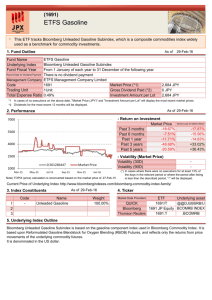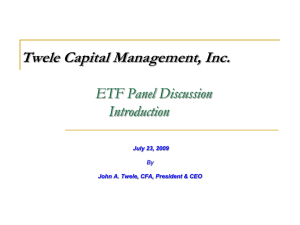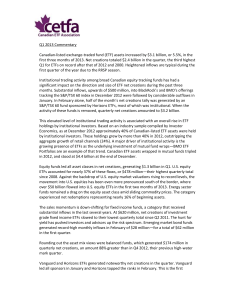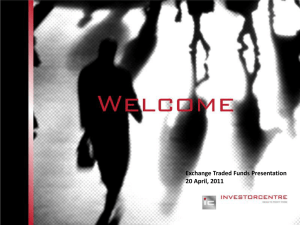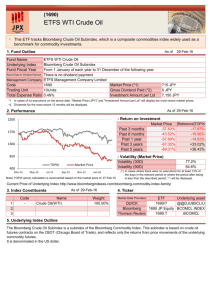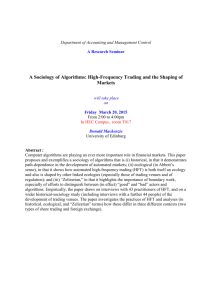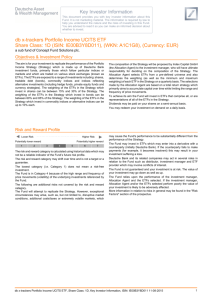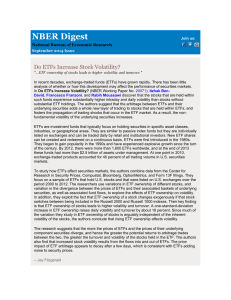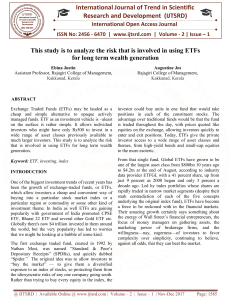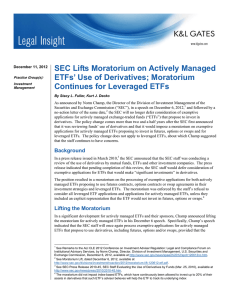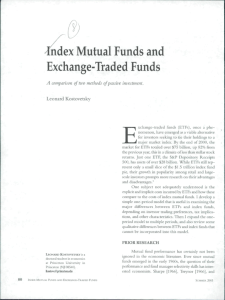Financial News Keeping ETF prices on track Sarah Krouse 2014-05-19
advertisement
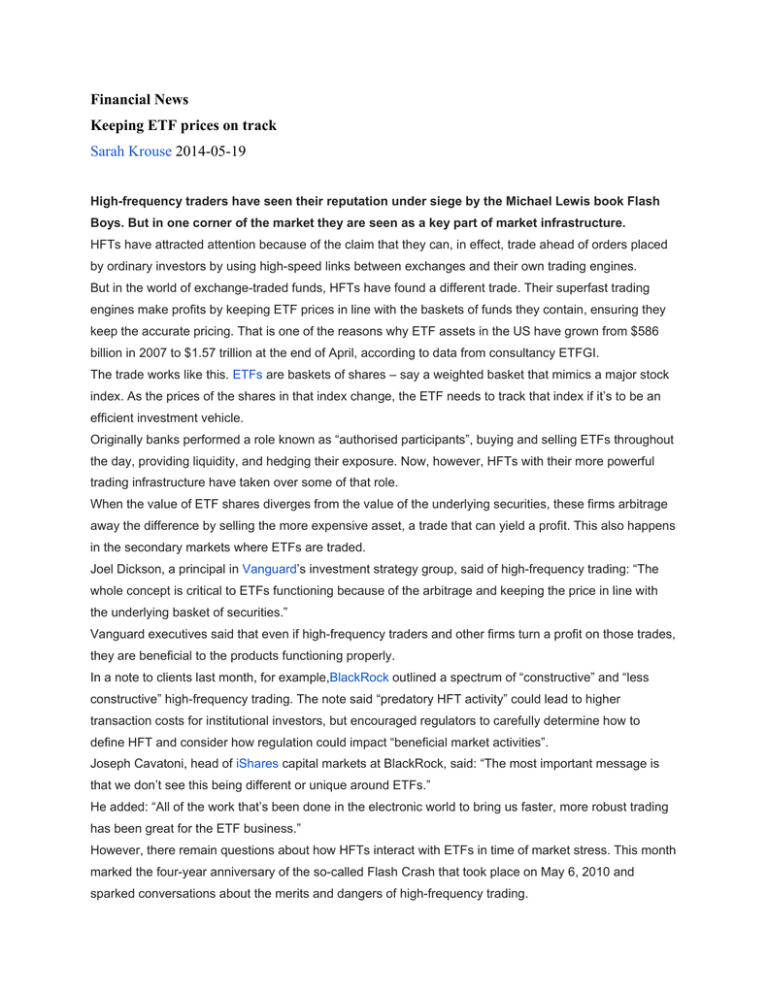
Financial News Keeping ETF prices on track Sarah Krouse 2014-05-19 High-frequency traders have seen their reputation under siege by the Michael Lewis book Flash Boys. But in one corner of the market they are seen as a key part of market infrastructure. HFTs have attracted attention because of the claim that they can, in effect, trade ahead of orders placed by ordinary investors by using high-speed links between exchanges and their own trading engines. But in the world of exchange-traded funds, HFTs have found a different trade. Their superfast trading engines make profits by keeping ETF prices in line with the baskets of funds they contain, ensuring they keep the accurate pricing. That is one of the reasons why ETF assets in the US have grown from $586 billion in 2007 to $1.57 trillion at the end of April, according to data from consultancy ETFGI. The trade works like this. ETFs are baskets of shares – say a weighted basket that mimics a major stock index. As the prices of the shares in that index change, the ETF needs to track that index if it’s to be an efficient investment vehicle. Originally banks performed a role known as “authorised participants”, buying and selling ETFs throughout the day, providing liquidity, and hedging their exposure. Now, however, HFTs with their more powerful trading infrastructure have taken over some of that role. When the value of ETF shares diverges from the value of the underlying securities, these firms arbitrage away the difference by selling the more expensive asset, a trade that can yield a profit. This also happens in the secondary markets where ETFs are traded. Joel Dickson, a principal in Vanguard’s investment strategy group, said of high-frequency trading: “The whole concept is critical to ETFs functioning because of the arbitrage and keeping the price in line with the underlying basket of securities.” Vanguard executives said that even if high-frequency traders and other firms turn a profit on those trades, they are beneficial to the products functioning properly. In a note to clients last month, for example,BlackRock outlined a spectrum of “constructive” and “less constructive” high-frequency trading. The note said “predatory HFT activity” could lead to higher transaction costs for institutional investors, but encouraged regulators to carefully determine how to define HFT and consider how regulation could impact “beneficial market activities”. Joseph Cavatoni, head of iShares capital markets at BlackRock, said: “The most important message is that we don’t see this being different or unique around ETFs.” He added: “All of the work that’s been done in the electronic world to bring us faster, more robust trading has been great for the ETF business.” However, there remain questions about how HFTs interact with ETFs in time of market stress. This month marked the four-year anniversary of the so-called Flash Crash that took place on May 6, 2010 and sparked conversations about the merits and dangers of high-frequency trading. The market dropped sharply for a few minutes following a computer trading system failure, with the Dow Jones Industrial Average falling almost 1000 points. The failure caused huge hiccups for trading in the baskets of underlying securities in ETFs. In Congressional testimony after the event,Mary Schapiro, then-chairman of the Securities and Exchange Commission, said the shares of more than a quarter of all ETFs suffered “temporary price declines” of more than 50%. Flash Crash A BlackRock survey of 380 retail financial advisers after the Flash Crash found that the majority of those surveyed believed market structure issues, including an over-reliance on computer systems and some forms of HFT, were drivers of the crash. The trade by HFTs in ETFs was not identified as a cause of the Flash Crash. But it served to highlight the problems of complexity and the unpredictability of markets with so many automated agents, and made some investors wary of it. Although ETFs look on the surface like a simple product, underneath there is a sophisticated infrastructure with HFTs as a key component. ETFs have also recently faced criticism for creating volatility in the prices of the underlying baskets of shares they contain. Last month, researchers at Ohio State University, the University of Lugano and theUniversity of Pennsylvania published a paper that found that stocks owned by ETFs showed “significantly higher intraday and daily volatility”. The authors of the paper, Itzhak Ben-David, Francesco Franzoni and Rabih Moussawi, studied ETFs between 2000 and 2012 and concluded that ETFs attract “a new clientele”, including high-frequency traders with higher turnover than typical stock investors. They wrote: “The driving channel appears to be arbitrage activity between ETFs and the underlying stocks.” While there are concerns about predatory high-frequency trading, providers and marketmakers fear that too much regulation could diminish the ability to keep ETF prices reflective of the value of the underlying assets. Financial News reported last week that some providers and marketmakers are in discussions with IEX, a new venue started by Brad Katsuyama and featured in Flash Boys. Jay Fraser, head of business development at IEX, told Financial News at the time: “We’ve gotten indications from marketmakers that IEX provides a safe experience for them to provide liquidity in a nontoxic environment. This naturally leads to a good experience for people trading and providing liquidity in ETFs.”
